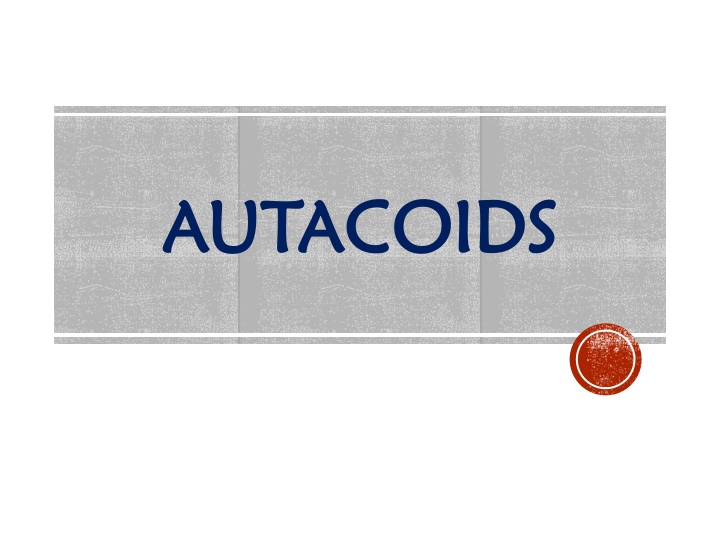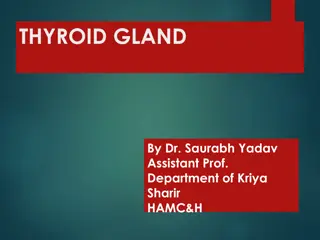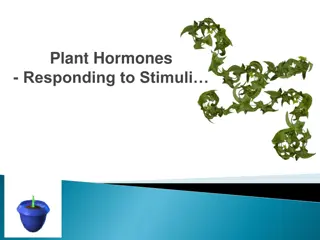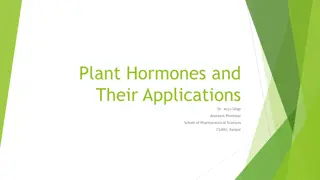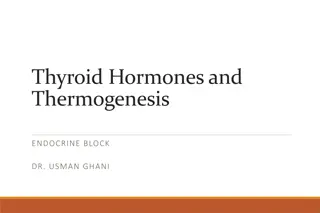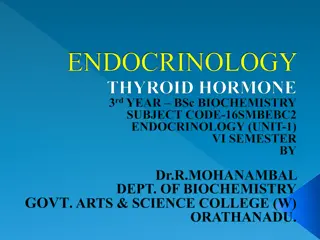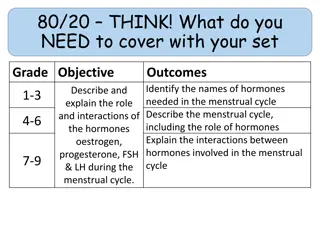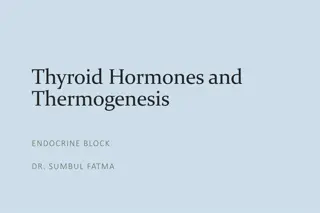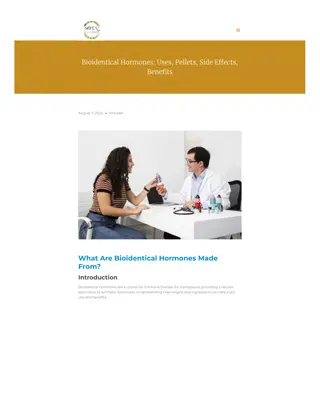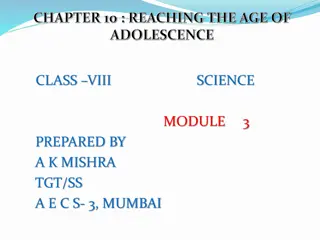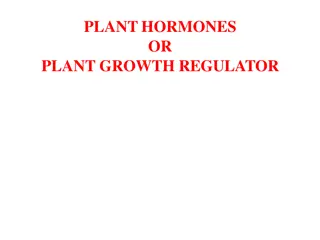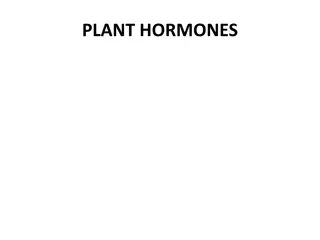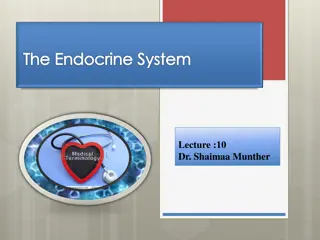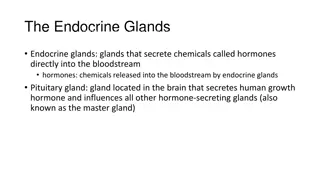Autacoids: Local Hormones and Their Role in the Body
Autacoids, also known as local hormones, are substances produced by various tissues that act locally to regulate the activity of smooth muscles, nerves, platelets, and other tissues. They play a crucial role in pain, inflammation, allergic reactions, and more. Serotonin, a key autacoid, has diverse functions in the body. Understanding the distribution, biosynthesis, and degradation of autacoids like serotonin provides insights into their physiological roles and clinical implications.
Download Presentation

Please find below an Image/Link to download the presentation.
The content on the website is provided AS IS for your information and personal use only. It may not be sold, licensed, or shared on other websites without obtaining consent from the author.If you encounter any issues during the download, it is possible that the publisher has removed the file from their server.
You are allowed to download the files provided on this website for personal or commercial use, subject to the condition that they are used lawfully. All files are the property of their respective owners.
The content on the website is provided AS IS for your information and personal use only. It may not be sold, licensed, or shared on other websites without obtaining consent from the author.
E N D
Presentation Transcript
AUTACOIDS AUTACOIDS
Autacoids (also spelled autocoids) or local hormones are substances produced by different tissues throughout the body and act locally in brief duration to modulate the activity of smooth muscles, nerves, platelets, and other tissues. Several autacoids also serve as neurotransmitters in the central nervous system (CNS) or enteric nervous system. Autacoids are involved in pain, fever, inflammation, allergic reactions, asthma, thromboembolic disorders, and other pathologic conditions. Drugs that Drugs that inhibit autacoid synthesis or block autacoid receptors are helpful in treating these conditions, whereas drugs that activate autacoid receptors are useful for inducing labor, alleviating migraine headaches, counteracting drug-induced peptic ulcers, and other purposes. Autacoids include monoamines, such as serotonin and histamine, as well as fatty acid derivatives, including prostaglandins and leukotrienes and Peptide autacoids:Plasma kinins (Bradykinin, Kallidin) and angiotensin.
Autacoids activate specific membrane receptors in target tissues, mostly of the G protein coupled receptor type. Their effects are usually restricted to the tissue in which they are formed, but under pathologic conditions, extraordinarily large amounts of autacoids can be released into the systemic circulation. These disorders include carcinoid tumor and anaphylactic shock, which cause the release of large amounts of serotonin and histamine, respectively, and exerting systemic effects . Most autacoids are rapidly metabolized to inactive compounds, as seen with prostaglandins, and some autacoids undergo tissue reuptake, as evidenced by 5- hydroxytryptamine (5-HT) reuptake transporter proteins in neurons and peripheral cells.
SEROTONIN Serotonin (5-hydroxytryptamine,5HT) is an important neurotransmitter, a local hormone in the gut or peripheral vascular system, a component of the platelet clotting process, and is thought to play a role in migraine headache. Because of its broad and largely undesirable peripheral effects, serotonin has no clinical application in the treatment of disease. However, compounds that selectively activate certain receptor subtypes or selectively antagonize the actions of this amine are of considerable clinical value.
DISTRIBUTION, BIOSYNTHESIS AND DEGRADATION 5-Hydroxytryptamine occurs in the highest concentrations in three organs: In the gut wall. Over 90% of the total amount in the body is present in the enterochromaffin cells)a type of neuroendocrine cell found in the gastric glands of the gastric mucosa (.Some 5-HT also occurs in nerve cells of the myenteric plexus, where it functions as an excitatory neurotransmitter. In blood. 5-HT is present in high concentrations in platelets, which accumulate it from the plasma by an active transport system and release it when they aggregate at sites of tissue damage. In the CNS. 5-HT is a neurotransmitter in the CNS and is present in high concentrations in localized regions of the midbrain.
Although 5-HT is present in the diet, most of this is metabolized before entering the bloodstream. Endogenous 5-HT is synthesized in biologic systems from the amino acid L-tryptophan which is converted to 5- hydroxytryptophan by the action of tryptophan hydroxylase, an enzyme confined to 5-HT-producing cells. The 5- hydroxytryptophan is then decarboxylated to 5-HT by amino acid decarboxylase . Hydroxylation by tryptophan hydroxylase-1 is the rate-limiting step and can be blocked by p-chlorophenylalanine and by p- chloroamphetamine. These agents have been used experimentally to reduce serotonin synthesis in carcinoid syndrome but are too toxic for general clinical use. Telotristat ethyl, an orally active hydroxylase inhibitor, has been approved for the treatment of diarrhea due to carcinoid tumor.
5-HT is often stored in neurons and enterochromaffin cells as a co-transmitter. Platelets (and neurons) possess a high-affinity 5-HT uptake mechanism by an amine pump serotonin transporter (SERT). They become loaded with 5-HT as they pass through the intestinal circulation, where the local concentration is relatively high. Selective serotonin reuptake inhibitors (SSRIs) have been developed and are important therapeutically as anxiolytics and antidepressants. There is evidence for genetic defects in this reuptake system in irritable bowel syndrome , which might explain the rather bewildering symptoms of the disease. The mechanisms of synthesis, storage, release and reuptake of 5- HT are very similar to those of noradrenaline. Degradation of 5-HT occurs mainly through oxidative deamination, catalyzed by monoamine oxidase A, followed by oxidation to 5-hydroxyindoleacetic acid (5-HIAA).5-HIAA is excreted in the urine and serves as an indicator of 5-HT production in the body.
PHARMACOLOGICAL EFFECTS The actions of 5-HT are numerous and complex. The main sites of action are as follows: Gastrointestinal tract: 5-HT serves complex and important roles in the regulation of gastrointestinal function . Most 5-HT receptor subtypes are present in the gut with the exception of those of the 5-HT 5/6 receptor family. Only about 10% of 5-HT in the intestine is located in neurons, where it acts as a neurotransmitter, while the remainder is located in the enterochromaffin cells, which act as sensors to transduce information about the state of the gut. 5-HT initiates secretory reflexes & increases gastrointestinal motility (by direct excitation of smooth muscle and indirect action via enteric neurons)
Serotonin is also one of the mediators of the signs and symptoms of carcinoid syndrome (an unusual manifestation of carcinoid tumor, a neoplasm of enterochromaffin cells) such as diarrhea, bronchoconstriction, flush and abdominal cramping or pain. In patients whose tumor is not operable, a serotonin antagonist may constitute a useful treatment. Smooth muscle: In many species (although only to a minor extent in humans), smooth muscle (e.g. uterus and bronchial tree) is contracted by 5-HT.
Blood vessels: The effect of 5-HT on blood vessels depends on various factors, including the size of the vessel and the sympathetic activity. Large vessels, both arteries and veins, are usually constricted by 5-HT (mediated through 5-HT2A receptors). This is a direct action on vascular smooth muscle cells. Activation of 5-HT1 receptors causes constriction of large intracranial vessels, which their dilatation causes migraine headache. Serotonin can also elicit reflex bradycardia by activation of 5-HT3 receptors on chemoreceptor nerve endings. 5-HT, can cause vasodilatation of small blood vessels, partly by acting on endothelial cells to release nitric oxide and partly by inhibiting noradrenaline release from sympathetic nerve terminals. If 5-HT is injected intravenously, triphasic blood pressure response is often seen. Initially, there will be sharp fall in blood pressure due to the chemoreceptor response. Then, it rises owing to the constriction of large vessels, and then falls, owing to arteriolar dilatation 5-HT may play a role in the pathology of pulmonary hypertension
Platelets: 5-HT causes platelet aggregation by acting on 5- HT2Areceptors and the platelets that collect in the vessel release further 5-HT. If the endothelium is intact, 5-HT release from adherent platelets causes vasodilatation, which helps to sustain blood flow; if it is damaged (e.g. by atherosclerosis), 5-HT causes constriction (as vasodilatation requires the presence of vascular endothelial cells) and impairs blood flow further. These effects of platelet-derived 5-HT are thought to be important in vascular disease.
Nerve endings: 5-HT stimulates nociceptive (pain-mediating) sensory nerve endings an effect mediated mainly by 5-HT3 receptors. If injected into the skin, 5-HT causes pain. 5-HT also inhibits transmitters release from adrenergic neurons in the periphery. Central nervous system: 5-HT excites some neurons and inhibits others; it may also act presynaptically to inhibit transmitters release from nerve terminals. Brain serotonergic neurons are involved in numerous diffuse functions such as mood, sleep, appetite, and temperature regulation, as well as the perception of pain and vomiting. Serotonin also appears to be involved in clinical conditions such as depression, anxiety, and migraine.
5-Hydroxytryptamine receptors& main acting drugs: There are seven types (5-HT1-7), with further subtypes of 5-HT1 (A-F) , 5-HT2(A-C) and 5-HT5 (A & B). 5-HT1receptors: occur mainly in central nervous system (CNS) (all subtypes) and some blood vessels. They function mainly as inhibitory presynaptic receptors. The effects are mediated through inhibition of adenylate cyclase and they include neural inhibition and vasoconstriction. Specific agonists : triptans (5-HT1B/D/F receptor agonist) as sumatriptan (used in migraine therapy) . Buspirone (acts at the 5-HT1A, used in anxiety treatment) and dihydroergotamine (used in migraine therapy) are partial agonists. Antagonists include spiperone ,methiothepin and cabergoline. Ketanserin is non-specific serotonin receptor antagonist effective in lowering blood pressure in essential hypertension. .
5-HT2receptors: occur in CNS and many peripheral sites (especially blood vessels, platelets, autonomic neurons). Neuronal and smooth muscle effects are excitatory. Some blood vessels dilated as a result of nitric oxide release from endothelial cells. 5-HT2receptors act through the phospholipase C/inositol triphosphate pathway. Specific ligands include lysergic acid diethylamide (LSD): a hallucinogenic drug ; agonist in CNS, antagonist in periphery). Lorcaserin is a newer serotonin agonist, with selectivity for the (5-HT2C). It is used for chronic weight management. Antagonists include ergotamine, methysergide (used for migraine prophylaxis &carcinoid syndrome) cyproheptadine(has H1 antihistamine activity so used in allergic reactions and as an appetizer and to reduce spasms following spinal cord injury & also used for carcinoid tumor), ketotifen(used for asthma prophylaxis), pizotifen(used for migraine prophylaxis). Flibanserin,a 5- HT1A agonist and 5-HT2A antagonist, is a new drug indicated for the treatment of premenopausal women with hypoactive sexual desire disorder.
5-HT3receptors occur in peripheral nervous system, especially nociceptive afferent neurons and enteric neurons, and in CNS. Effects are excitatory, mediated through direct receptor-coupled ion channels. Specific agonist is 2-methyl-5-HT.Specific antagonists include ondansetron, granisetron, palonosetron and tropisetron. Antagonists are used mainly as antiemetic drugs particularly for controlling the severe nausea and vomiting that occurs with many forms of cancer chemotherapy, but may also be anxiolytic. Alosetron is indicated for treatment of women with irritable bowel syndrome with predominant diarrhea. 5-HT4receptors occur mainly in the enteric nervous system (also in CNS). Effects are excitatory, through stimulation of adenylate cyclase, causing increased gastrointestinal motility. Specific agonist is metoclopramide (an anti-emetic which stimulates gastric emptying). Little is known so far about the function and pharmacology of 5-HT5-7receptors.
ERGOT ALKALOIDS Ergot alkaloids constitute a hard-to-classify group of drugs. Many of them act on 5-HT receptors, but not selectively, and their actions are complex and diverse. These complex molecules based on lysergic acid (a naturally occurring tetracyclic alkaloid). They are produced by a fungus (Claviceps purpurea) found in wet or spoiled grain. They are responsible for the epidemics of St. Anthony s fire (ergotism) described during the Middle Ages and recurring to the present time. The important members of the group include various naturally occurring and synthetic derivatives. These compounds display many different types of pharmacological action.
Dopamine receptor Uterine contraction Side effects etc. Adrenoceptor Drug 5-HT receptor Main uses Antagonist/ partial agonist (5-HT1) Antagonist (other sites) Partial agonist (blood vessels) Inactive ++ Migraine Emesis, Vaso- constriction (avoid in peripheral vascular disease) Avoid in pregnancy Ergotamine Antagonist/ partial agonist (5-HT1) Antagonist/pa rtial agonist (5-HT1) (weak) Antagonist Inactive + Migraine Less emesis than with ergotamine abortion Dihydro- ergotamine Weak antagonist/pa rtial agonist Weak +++ Prevention of postpartum hemorrhage Ergometrine (ergonovine) Inactive Weak antagonist Agonist/ partial agonist -Parkinson's disease -Endocrine disorders (Hyperprolact inaemia ) -Carcinoid syndrome -Migraine (prophylaxis) Emesis Bromocriptine Cabergoline & pergolide - Methylsergide Antagonist/pa rtial agonist (5-HT2) - - - Retroperiton eal and mediastinal fibrosis Emesis
Most of the effects of ergot alkaloids appear to be mediated through adrenoceptors, 5-HT or dopamine receptors, although some effects may be produced through other mechanisms. All alkaloids stimulate smooth muscle, some being relatively selective for vascular smooth muscle while others act mainly on the uterus. Toxicity & Contraindications The most common toxic effects of the ergot derivatives are gastrointestinal disturbances, including diarrhea, nausea, and vomiting. Since migraine attacks are often associated with these symptoms before therapy is begun, these adverse effects are rarely contraindications to the use of ergot. A more dangerous toxic effect usually associated with overdosage of agents like ergotamine and ergonovine is prolonged vasospasm. This sign of vascular smooth muscle stimulation may result in gangrene and may require amputation. Vasospasm caused by ergot is refractory to most vasodilators, but infusion of large doses of nitroprusside or nitroglycerin has been successful in some cases.
Chronic therapy with methysergide was associated with connective tissue proliferation in the retroperitoneal space, the pleural cavity, and the endocardial tissue of the heart which impairs the functioning of the gastrointestinal tract, kidneys, heart and lungs. Contraindications to the use of ergot derivatives consist of the obstructive vascular diseases, especially symptomatic coronary artery disease, and collagen diseases.
